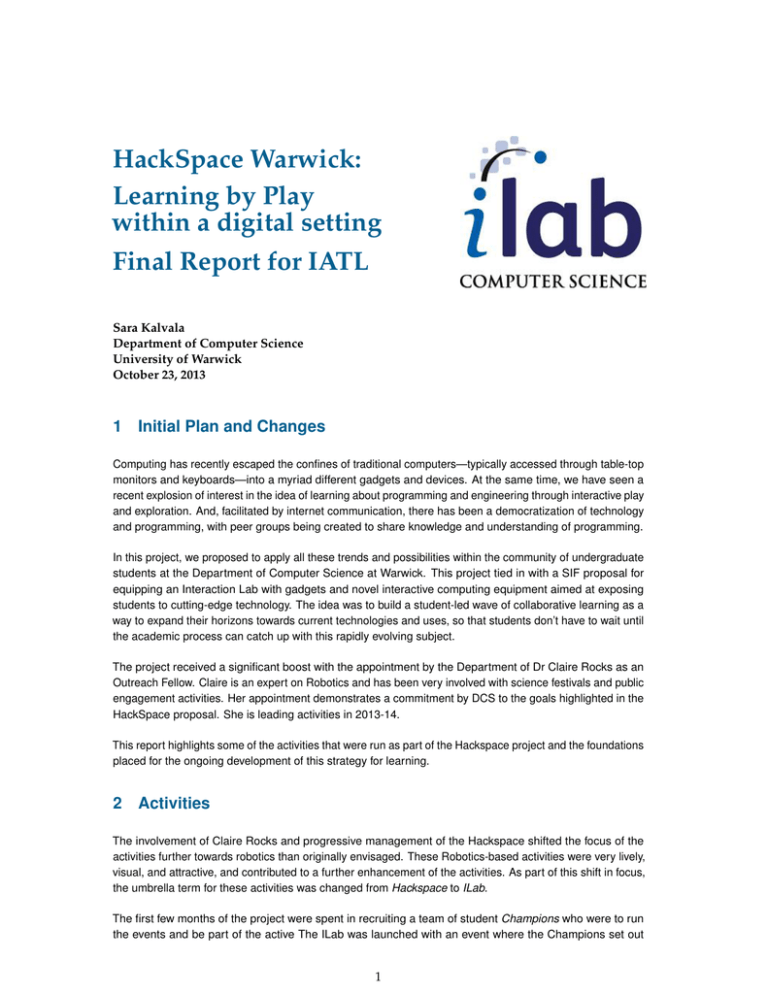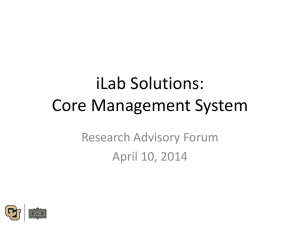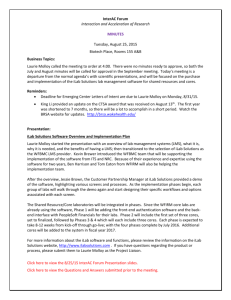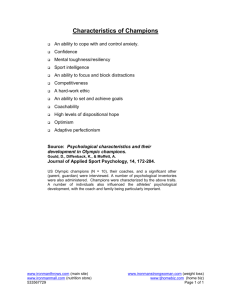HackSpace Warwick: Learning by Play within a digital setting Final Report for IATL
advertisement

HackSpace Warwick: Learning by Play within a digital setting Final Report for IATL Sara Kalvala Department of Computer Science University of Warwick October 23, 2013 1 Initial Plan and Changes Computing has recently escaped the confines of traditional computers—typically accessed through table-top monitors and keyboards—into a myriad different gadgets and devices. At the same time, we have seen a recent explosion of interest in the idea of learning about programming and engineering through interactive play and exploration. And, facilitated by internet communication, there has been a democratization of technology and programming, with peer groups being created to share knowledge and understanding of programming. In this project, we proposed to apply all these trends and possibilities within the community of undergraduate students at the Department of Computer Science at Warwick. This project tied in with a SIF proposal for equipping an Interaction Lab with gadgets and novel interactive computing equipment aimed at exposing students to cutting-edge technology. The idea was to build a student-led wave of collaborative learning as a way to expand their horizons towards current technologies and uses, so that students don’t have to wait until the academic process can catch up with this rapidly evolving subject. The project received a significant boost with the appointment by the Department of Dr Claire Rocks as an Outreach Fellow. Claire is an expert on Robotics and has been very involved with science festivals and public engagement activities. Her appointment demonstrates a commitment by DCS to the goals highlighted in the HackSpace proposal. She is leading activities in 2013-14. This report highlights some of the activities that were run as part of the Hackspace project and the foundations placed for the ongoing development of this strategy for learning. 2 Activities The involvement of Claire Rocks and progressive management of the Hackspace shifted the focus of the activities further towards robotics than originally envisaged. These Robotics-based activities were very lively, visual, and attractive, and contributed to a further enhancement of the activities. As part of this shift in focus, the umbrella term for these activities was changed from Hackspace to ILab. The first few months of the project were spent in recruiting a team of student Champions who were to run the events and be part of the active The ILab was launched with an event where the Champions set out 1 Figure 1: ILab Launch event, December 2012 Figure 2: ILab Show and Tell, and SIBE Hackathon demonstrations of fun and interactive gadgets and their own initial programs for dealing with them. The Department contributed refreshments and the event was attended by undergraduate and postgraduate students as well as staff members. A further outreach event was the Show and Tell sponsored by the British Computer Society in February. These Show and Tell events are supposed to highlight ‘exciting and inspiring in-progress projects and new toys’. Our Champions had an active role in the running of the event, and provided a coherent view of the projects developed by them. In particular, their maze-solving robots were very popular among visitors both within the University as well as from outside. Finally, we collaborated with SIBE (http://www.sibe.co.uk) to organize a Hackathon, where students and non-students were encouraged to contribute initial approaches to collaborative decision-making on social campaigns. While SIBE members provided the problem and initial thoughts, members of the ILab and the DCS students helped formalize the specifications and decide on the software stack for collaboration. DCS and ILab also provided support for the event itself, and contributed to the prizes awarded. These major events were interspersed with weekly surgeries, where the Champions were available to work with both students and staff members on helping with gadgetrelated projects. The one-to-one availability of champions was particularly useful for students already using the Android platform for their academic projects but also staff and students who wanted to get started with writing their own Apps and games. The Champions were responsible for bringing the necessary hardware kits (small robots, Android tablets, Raspberry kits, etc) to the sessions and be available to answer questions. Mostly they also brought maze-running robots which were playful and interactive tools to attract more casual participants. Figure 3: Surgeries The Champions also took an active role in University and Departmental Open Days and introduced prospective students to the idea of a student-led approach to supporting the development of computing skills. The fact 2 that these activities were all badged as being ILab activities (and sponsored through an IATL grant) gave them coherence and moreover gave the students involved a sense of coherence and responsibility. 3 Outcomes The principal outcome from the Hackspace project was the initial goal: to encourage students to expand their study and development with a sense of exploration and play, mediated by digital devices. Many students have decided to do their final year individual projects on gadget-based ideas: the proportion of these projects went from 15.7% in 11-12 to 24.7% in 12-13. It could be argued that these projects are, for the students involved, more immediate and more realistic than some of the usual artificial settings the students would have to model. One could ask if this increasin gadget-based projects would have happened anyway without the visibility provided by the ILab. From talking to students, it is clear that having a library of gadgets that they could play with before deciding on the topic, and knowing that there were peers who were willing to help them in an informal setting, made a difference in theircommitment to such a project. In retrospect, the commitment expected from the Champions was unrealistic. While the chosen students all showed a lot of eenthusiasm and dedication, they had their academic responsibilities to take care of, which quite obviously needed to take precedence. Furthermore, we hoped that they would develop a sense of leadership and some of them would naturally coordinate the efforts of the others, however in the end this did not occur. The initial plan was to have four Champions, but in the end we had more students, in order to distribute the onus and also to make use of a greater range of expertise and interest. Another issue that slowed the issue somewhat was the difficulties in setting up a physical ILab. One large lab space at DCS was earmarked for refurbishment and the plan was to set up a dedicated corner for the ILab. In practice, the refurbishment took much longer than expected, and some of the activities had to take place in different rooms. Moreover, it is still difficult to ensure a permanent space where students could come in and leave half-finished hardware projects over several days. There was some amount of administration involved in keeping an inventory of gadgets available and ensuring that these could reach possible users as required. The efforts in terms of engagement with the wider community were certainly successful. The Champions were very active in Open Days, and the fact that they used the ILab T-shirts and talked about the extra-curricular approach to programming gadgets was a hit with potential students. In fact, our recruitment of students this year was very successful and the enthusiasm displayed by students in general and Champions in particular was noted by visitors who expressed an overall positive opinion at the end of their visits. At the start of the period of the project the University had launched the Global Priority Priority Programs and one of them was titled Digital Change; this seemed like an ideal umbrella under which to develop activities and links at the University at large. In fact, in initial meetings it seemed that there was a possibility of using ideas from Humantities in driving some student-led activities within ILab. However, over the year it seems the direction of the GPP (and even its name, to Digital Humanities) changed significantly to more of a development of social media, and we weren’t able to build a solid plan of action in this regard. However, a later connection with Amber Thomas and also with SIBE resulted in some connections, which we are keen to explore further in the months to come. 4 Implications Overall, the project succeeded in capturing and exploring the increasing interest in student- and user-led learning of computing principles. We encouraged students, most of them who already have powerful equipment in their pockets, to think not only about using existing applications but develop their own. 3 However, we recognize that the outcomes of the project have been modest. The main difficulty we faced was to ensure that the project should be student-led, and yet we could not in fact ensure that the students had enough time and initiative to take the project forward. Students have many didactic activities an deadlines as part of their formal studies, and we were keen to not disturb them significantly during term. Even scheduling ILab events proved to be problematic: finding times when students from the same program can particupate is difficult enough, as we are encouraged to leave Wednesdays free. The difficulty is much greater when trying to bring together students from different years of studies. We let Champions decide on their ‘surgery’ times on an ad-hoc basis; this approach broke down towards the end of the academic year, when everyone’s schedules became somewhat full. The activities could not be moved to the vacation periods as they involved the Champions interacting with other students. Maybe the academic staff could have been more proactive in organizing the events, however our underlying thought was always that this should be a student-led initiative and therefore we should take a more supportive role behind the scenes, without driving the activities directly. Student-led initiatives are a great idea, however it remains difficult for academics involved to find the right level of involvement to avoid taking over while still ensuring progress. It also seems wise to use the first term of the year for such extra-curricular activities if at all possible: this catches students when they still have more availability and more enthusiasm. 5 Resources We have set up the infrastructure for continuing the student involvement in the ILab. The Department has invested in a library of gadgets, and these have been popular amongst students. Importantly, students took good care of any equipment entrusted in their care, and therefore the Department plans to keep the supply of equipment and update it for the next academic year. We have also worked to ensure there is now an established visual presence for the ILab. Champions have themselves developed an identity for the ILab, complemented by an online Wiki managed by them as well as more formal webpages maintained by academics, so this will ensure that in the new academic year students will already have a good idea of what may come. We have recruited champions for 2013-14 and the iLab activities for the year will be launched with an event on 24th October. Students will be challenged to build a controller for a robotic car using Raspberry Pis—and now we have enough infrastructure to hopefully support a big population of interested audience. Because the iLab has taken a distinctly hardware-oriented direction, we have launched a separate stream called Code Club which is being developed as a software co-operative effort. For 2013-14 we are not offering hourly compensation for the champions. Rather, we have a group of volunteers who will be using the experience as part of their coursework on project management. At the end of the year we will evaluate the success of this approach. 6 Further Information and Follow-up We set the foundations for a long-term engagement of the students and several of them have already been recruited for continuing with the project over the next year. The ILab initiative will be formally managed by Dr Claire Rocks in the 2013-14 academic year. Information on the ILab will still be made available through the main website: http://go.warwick.ac.uk/ilab. 4


